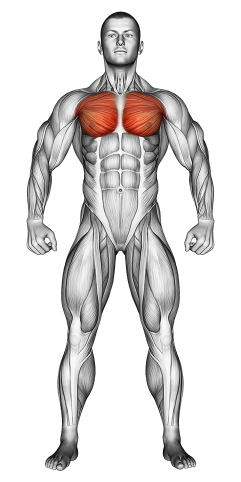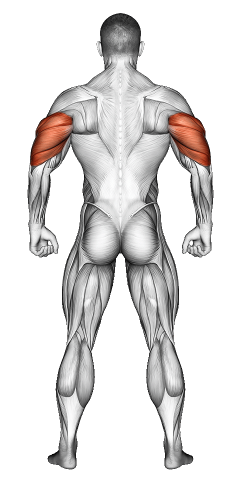Standing Dumbbell Chest Fly: Video Tutorial & Exercise Guide

Written By: Claude Michael
Updated: Oct 13, 2024
| Workout | Standing Dumbbell Chest Fly |
| Primary Muscle Group | Chest |
| Secondary Muscle Group | Shoulders, Triceps |
| Equipment Required | Dumbbell |
| Force Type | Push |
| Mechanics | Isolation |
| Exercise Type | Strength |
| Difficulty | Beginner |
Standing Dumbbell Chest Fly: Video Tutorial & Exercise Guide
- 1.Standing Dumbbell Chest Fly: Muscle Groups
- -1.1Primary Muscle Group
- -1.2Secondary Muscle Group
- 2.Standing Dumbbell Chest Fly: Step-by-Step Guide
- 3.Standing Dumbbell Chest Fly: Overview
- 4.Standing Dumbbell Chest Fly: Benefits
- 5.Standing Dumbbell Chest Fly: Pro Tips & Advanced Techniques
- 6.Standing Dumbbell Chest Fly: Progression Plan
- 7.Standing Dumbbell Chest Fly: Frequently Asked Questions (FAQs)
Standing Dumbbell Chest Fly: Step-by-Step Guide
- Step 1: Stand with your feet shoulder-width apart, holding a dumbbell in each hand with your palms facing each other. Keep a slight bend in your knees and engage your core for stability.
- Step 2: Extend your arms out in front of you at chest level, with a slight bend in your elbows. This is your starting position.
- Step 3: Open your arms to your sides in a controlled motion, maintaining the slight bend in your elbows. Lower the dumbbells until you feel a stretch in your chest.
- Step 4: Squeeze your chest muscles and bring the dumbbells back togClaude in front of you, returning to the starting position.
- Step 5: Repeat for the desired number of repetitions, maintaining control throughout the entire movement.
Standing Dumbbell Chest Fly: Overview
The Standing Dumbbell Chest Fly is a variation of the traditional chest fly exercise performed while standing. It primarily targets the pectoral muscles, with secondary activation of the shoulders and core for stability. The standing position adds a balance component, requiring the engagement of stabilizer muscles to maintain proper form throughout the movement.
This exercise is ideal for those looking to improve chest strength and definition, while also enhancing upper-body coordination and stability.
Standing Dumbbell Chest Fly: Benefits
The Standing Dumbbell Chest Fly is effective for isolating and strengthening the chest muscles, particularly the pectorals. It also engages the deltoids and core muscles as stabilizers, contributing to improved balance and coordination. This exercise promotes muscle symmetry and definition, making it a great addition to any chest-focused workout routine.
Additionally, standing while performing this exercise challenges your core and overall balance, which can enhance functional strength and stability.
Standing Dumbbell Chest Fly: Pro Tips & Advanced Techniques
Keep your elbows slightly bent throughout the movement to avoid placing unnecessary strain on your shoulder joints. Focus on a controlled, smooth motion to maximize muscle activation, and avoid swinging the dumbbells. To increase intensity, you can slow down the eccentric (lowering) phase of the movement or use heavier dumbbells. Be sure to engage your core to maintain balance and prevent your back from arching.
Standing Dumbbell Chest Fly: Progression Plan
Beginner
Intermediate
Advanced
Standing Dumbbell Chest Fly: Frequently Asked Questions (FAQs)
What muscles does the Standing Dumbbell Chest Fly target?
+This exercise primarily targets the pectoral muscles, with secondary engagement of the shoulders and core muscles for stability.
Can beginners perform the Standing Dumbbell Chest Fly?
+Yes, beginners can start with lighter weights to focus on mastering the movement and maintaining balance. It's a great exercise for building chest strength and muscle coordination.
How can I make the Standing Dumbbell Chest Fly more challenging?
+To increase the difficulty, you can use heavier weights, slow down the movement to increase time under tension, or add more repetitions to each set.
What common mistakes should I avoid during the Standing Dumbbell Chest Fly?
+Avoid locking your elbows or using momentum to swing the weights. Focus on controlled movements, and keep a slight bend in your elbows to reduce strain on your shoulders.
How often should I include the Standing Dumbbell Chest Fly in my routine?
+This exercise can be included 1-2 times per week as part of your chest or upper-body workout routine to improve chest definition and strength.
Share
Don’t Wish for It, Work for It – Join the FlexXP Newsletter Today!
Thank you for signing up for the FlexXP Newsletter!
This site is protected and the Google Privacy Policy and Terms of Service apply.


